 |
 |
 |
| |
Markers of Inflammation, Coagulation and Renal Function in HIV-infected Adults in SMART and in two Large Population-Based Studies, CARDIA and MESA: HIV+ have higher levels of inflammatory markers on and off HAART, "markers appear to predict mortality & disease progression in HIV"
|
| |
| |
Reported by Jules Levin
CROI 2009 Feb 8-12 Montreal
Jacqueline Neuhaus1 and David R. Jacobs Jr.1 for the INSIGHT SMART, MESA and CARDIA study groups
1Univ. of Minnesota, Minneapolis, USA
from Jules: see Figure 1a - for HIV+ 33-44 yrs old hsCRP and IL-6 are about 50% higher compared to HIV-negatives reflecting an increased risk for heart disease and comorbidities at a younger age, and this is a major point I understanding why HIV-positive individuals are at greater risk for experiencing comorbidities at a younger age compared to HIV-negatives. Undetectable and HAART reduce inflammation but do not normalize it. Exercise and diet are important in reducing inflammation. HIV-positives having greater inflammation compared to HIV-negatives is one of 3 crucial factors accelerating aging in HIV, the other 2 are HIV causes immune activation even with suppressed viremia, and HIV accelerates aging of naïve and memory T-cells. This accelerated aging process leads to greater risk for developing heart disease, bone loss, neurological complications, cognitive impairment, brain function, cancers, and perhaps more.
AUTHOR CONCLUSIONS
Compared to participants from two population-based cohorts (CARDIA and MESA), HIV-infected individuals in SMART had higher levels of inflammatory markers (as measured by hsCRP and IL-6), coagulation and fibrinolysis activity (as measured by D-dimer) and impaired renal function (as measured by cystatin-C).
These differences persisted after adjustment for cardiovascular risk factors.
Markers of inflammation, coagulation and renal function were elevated among
HIV-infected participants on effective ART as well as those not on ART.
The magnitude of the differences in these markers between HIV-infected
participants in SMART and in CARDIA and MESA are clinically relevant considering the prognostic importance of these markers in the general
population.
These markers also appear to be important predictors of mortality and disease progression among HIV-infected participants.1
Background
CD4+ guided episodic use of antiretroviral therapy (ART) as compared to continuous ART resulted in increased risk of opportunistic disease or death (hazard ratio = 2.6; p<0.001) and was associated with an 84% (p=0.007) increased risk of all-cause mortality in SMART.
Most of the excess mortality in episodic ART group was due to non-AIDS causes.
Elevated study entry levels of high sensitivity-C reactive protein (hsCRP), interleukin-6 (IL-6), and D-dimer were significantly related to all-cause mortality in SMART.
ART interruption led to significant increases in IL-6, D-dimer, and cystatin-C.
We compared study entry levels of hsCRP, IL-6, D-dimer and cystatin-C for participants in SMART with similar aged participants in two large population-based studies:
1) The Multi-Ethnic Study of Atherosclerosis (MESA); and
2) The Coronary Artery Risk Development in Young Adults (CARDIA) Study.
The goal of this comparison was to quantify the effect of HIV and HIV treatment on the four markers.
The hypothesis was that SMART participants, all of whom are HIV-infected, have
higher values of each of these markers than either the CARDIA or MESA participants, who were recruited from the general population and were unlikely to be HIV-infected.
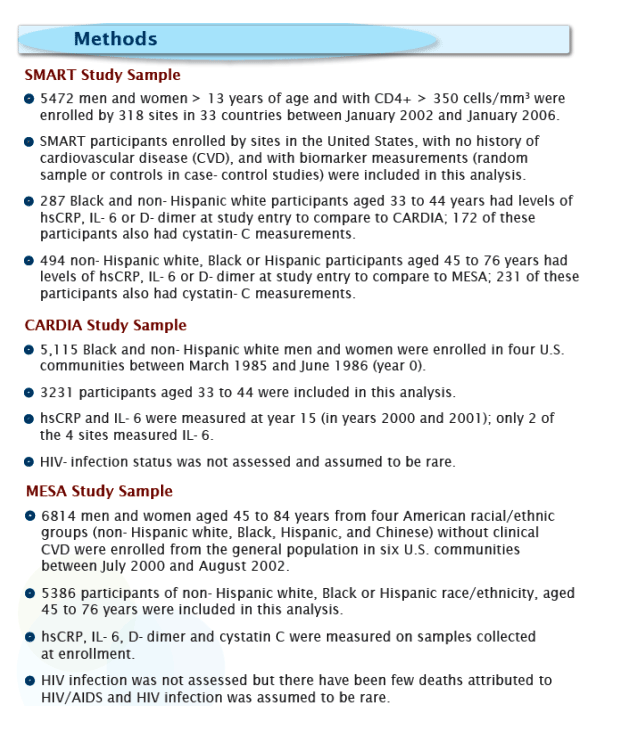
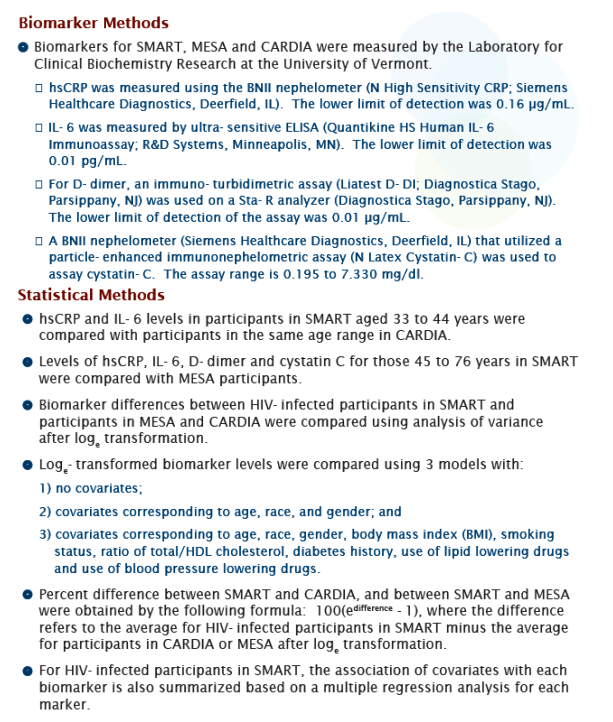
RESULTS
HIV-infected participants in SMART were more likely to be male, Black, smoke cigarettes, take lipid and blood pressure-lowering drugs, have higher total cholesterol/HDL ratios and lower body mass index than participants in CARDIA (Table 1a) and MESA (Table 1b).
The majority of participants in SMART were taking ART. The majority of HIV-infected participants on ART had HIV RNA levels <400 copies/mL: 68% for
those in the 33 to 44 year age group and 72% for those in the 45 to 76 year age group.
hsCRP, IL-6 and D-dimer were 50% to over 100% higher for HIV-infected participants in SMART compared to non-HIV infected participants in CARDIA (Table 2a) and MESA (Table 2b).
Cystatin C was 27% higher (95% CI: 19 to 31; p<0.001) in HIV-infected participants compared to participants in MESA (Table 2b).
With adjustment, percent differences between HIV-infected (SMART) participants and participants in the general population increased (Figure 1a for those aged
34-44 and Figure 1b for those aged 45-76).
hsCRP and IL-6 levels were 50% (95% CI: 26 to 79) and 63% (95% CI: 46 to 83) higher in non-smoking HIV-infected participants compared to nonsmoking participants in CARDIA. For non-smokers in SMART compared to non-smokers in MESA, levels of hsCRP, IL-6, D-dimer and cystatin C were 60% (95% CI: 41 to 81), 164% (95% CI: 146 to 184), 88% (95% CI: 70 to 108) and 29% (95% CI: 25 to 34) higher, respectively.
With the exception of D-dimer, the biomarkers did not vary for HIV-infected participants according to use of ART. Among participants 33 to 44 years, D-dimer was 62% (95% CI: 27 to 110; p<0.001) higher for participants not taking ART compared to those taking ART. For those aged 45 to 76 years, D-dimer levels were higher by a similar amount for those not taking ART compared to those on ART (63%; 95% CI: 31 to 101; p<0.001).
For both those not taking ART and taking ART, D-dimer levels were significantly higher compared to MESA participants by 127% for those not on ART and by 39% for those taking ART (p<0.001 for both).
There was evidence of interaction with gender for hsCRP (p=0.0005 for CARDIA comparison and p=0.01 for MESA comparison) but not for the other biomarkers. Both men and women with HIV-infection had higher adjusted levels of hsCRP than for participants of the same gender in CARDIA and MESA, Differences were larger for men [77% (p<0.0001) in CARDIA and 60% (p<0.0001) in MESA] than women [9% (p=0.48) in CARDIA and 26% (p=0.02) in MESA].
Differences in hsCRP levels between HIV-infected participants and those in the CARDIA and MESA cohorts were greater when participants in SMART with hepatitis C co-infection were excluded. After exclusion, percent differences for men were 97% (p<0.0001) for both age groups. The corresponding percentage differences for women were 25% (p=0.11) (SMART versus CARDIA) and 62% (p<0.0001) (SMART versus MESA). For both age groups the interaction with gender persisted (p=0.001 for CARDIA comparison and p=0.05 for MESA comparison) after the exclusion of participants in SMART with hepatitis C infection.
In a multiple regression analysis for all of the HIV-infected participants:
hsCRP levels were higher for older participants, women, smokers, those with higher BMI, those with higher total/HDL cholesterol, and those not co-infection with hepatitis C. IL-6 was higher for older participants, those with higher BMI, and smokers. D-dimer was higher for older participants, those with higher BMI, Blacks, women, those with diabetes, smokers, those not on lipid-lowering drugs and those with lower CD4+ cell counts. Cystatin C was higher for older participants, men, those with higher total/HDL cholesterol, those on blood pressure lowering drugs and those co-infected with hepatitis C.
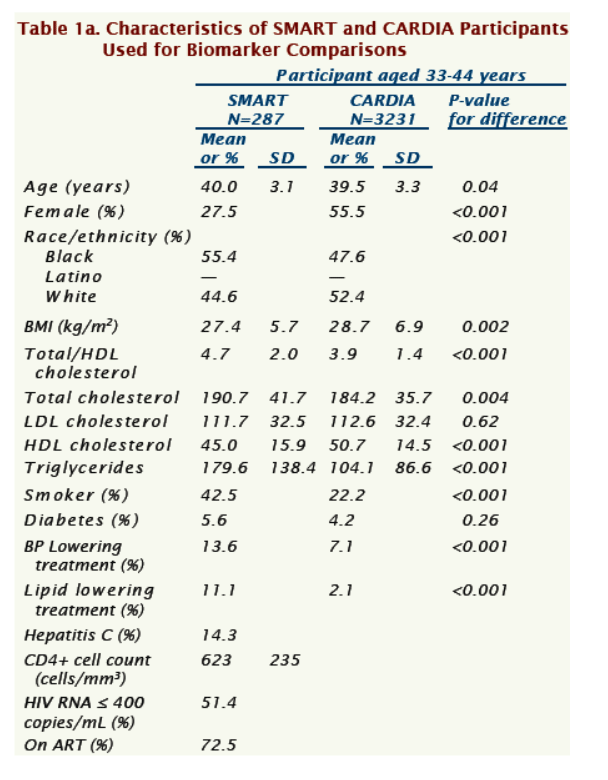
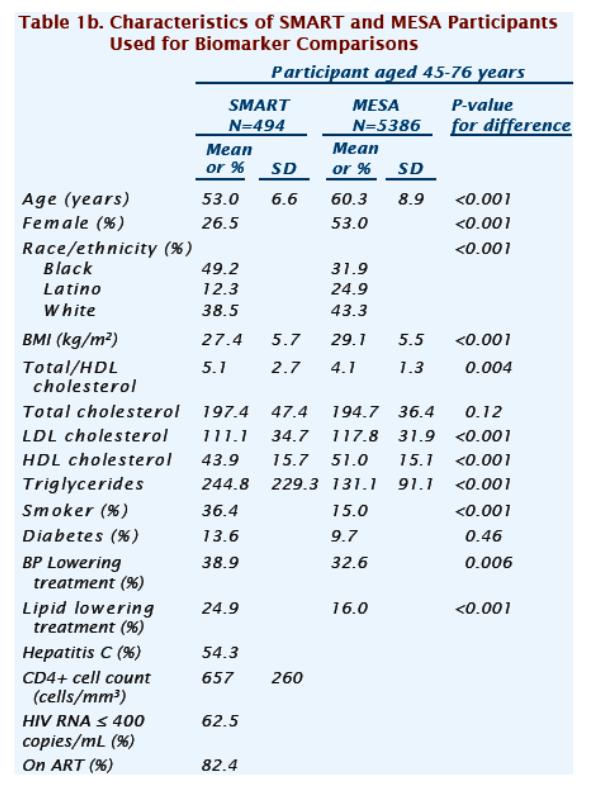
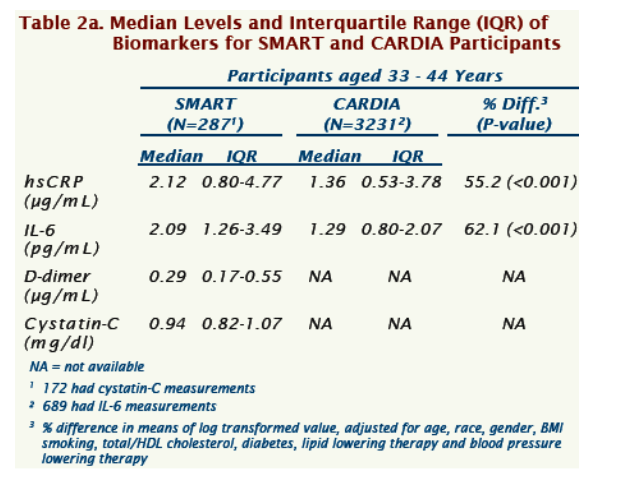
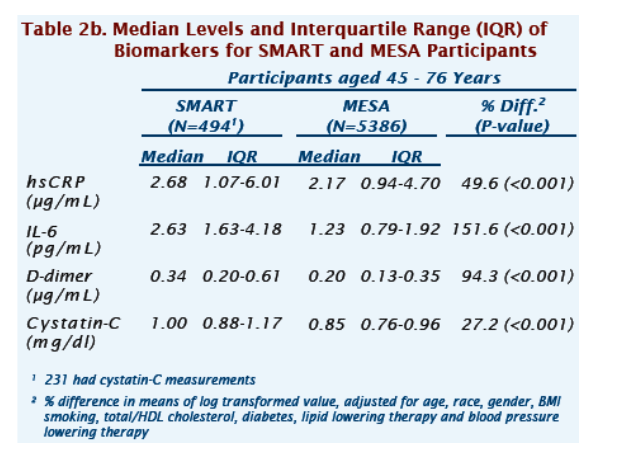
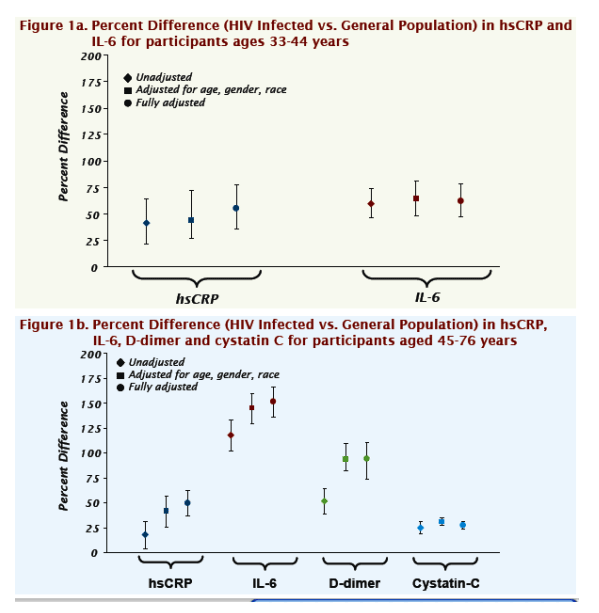
REFERENCE
1Kuller LH, Tracy R, Belloso W, De Wit S, Drummond F, Lane HC, et al for the INSIGHT SMART Study Group. Inflammatory and coagulation biomarkers and mortality in patients with HIV infection. PLoS Med 2008; 5(10):e203. doi:10.1371/journal.pmed.005.
|
| |
|
 |
 |
|
|